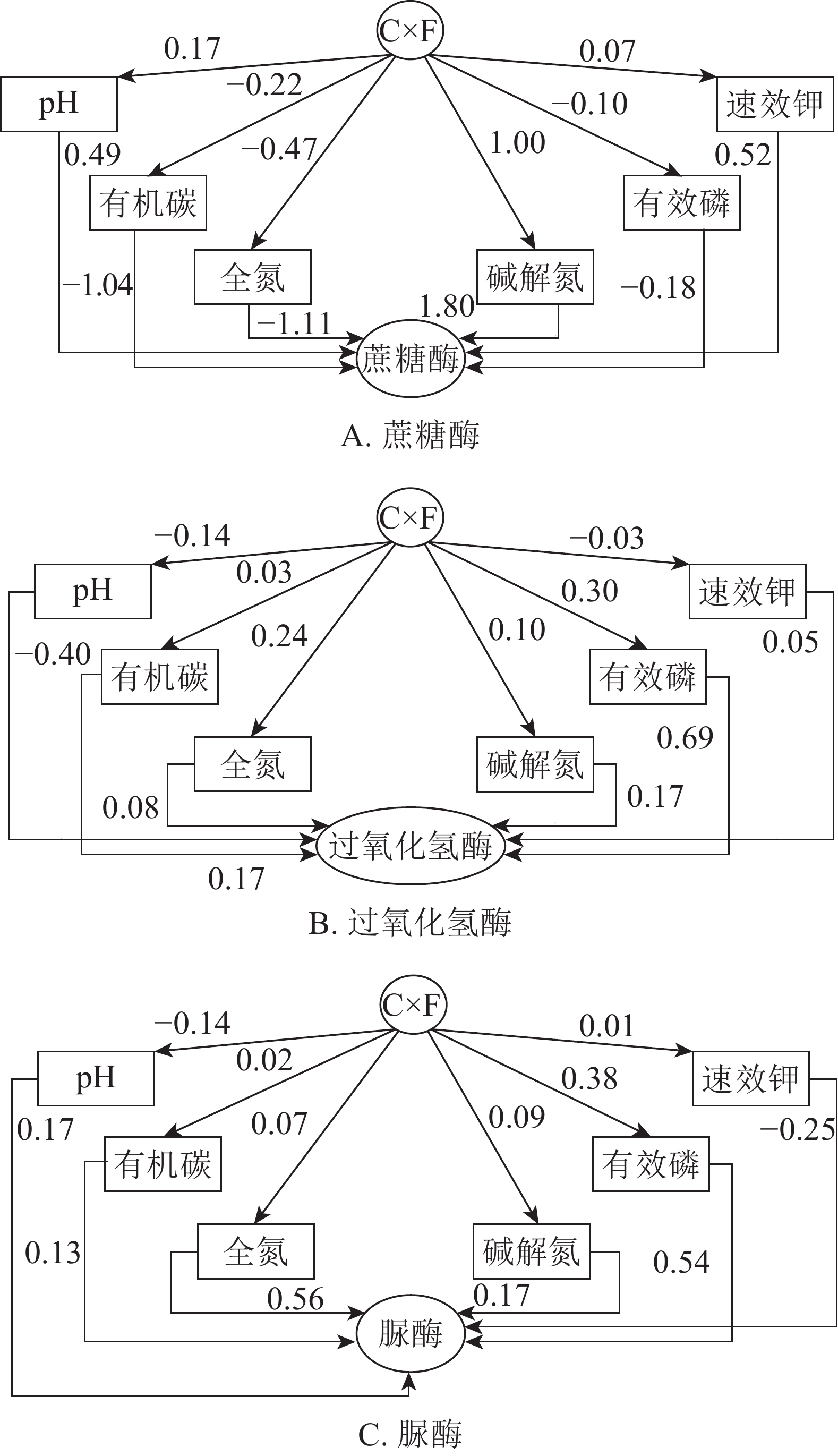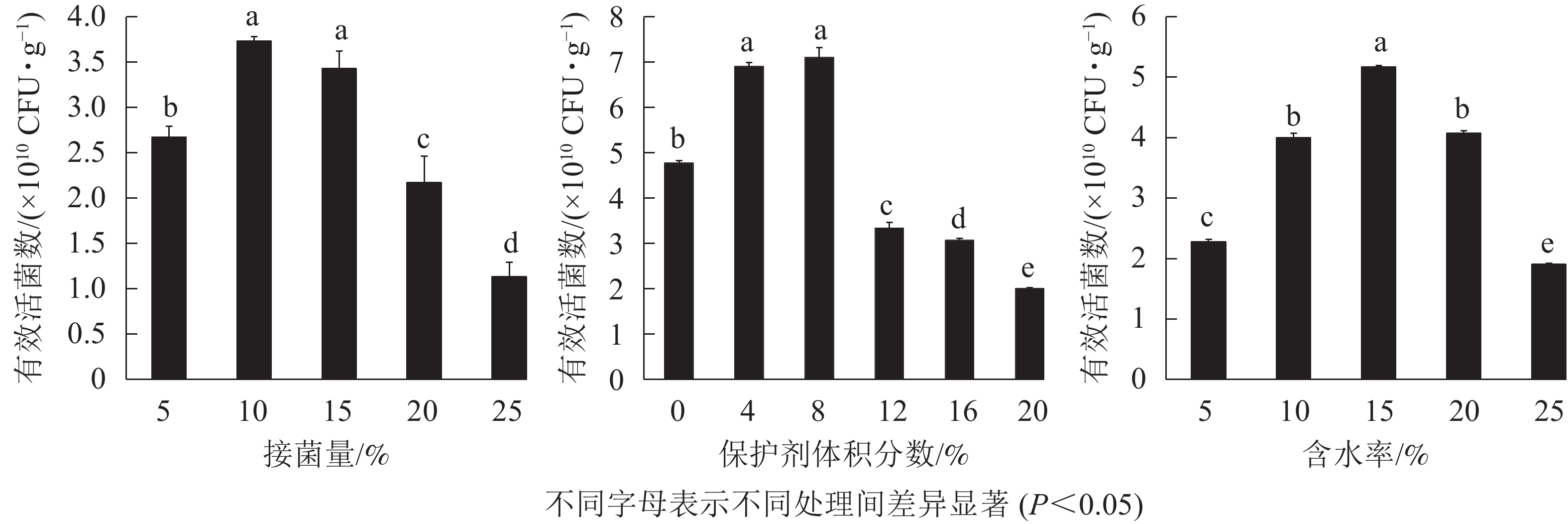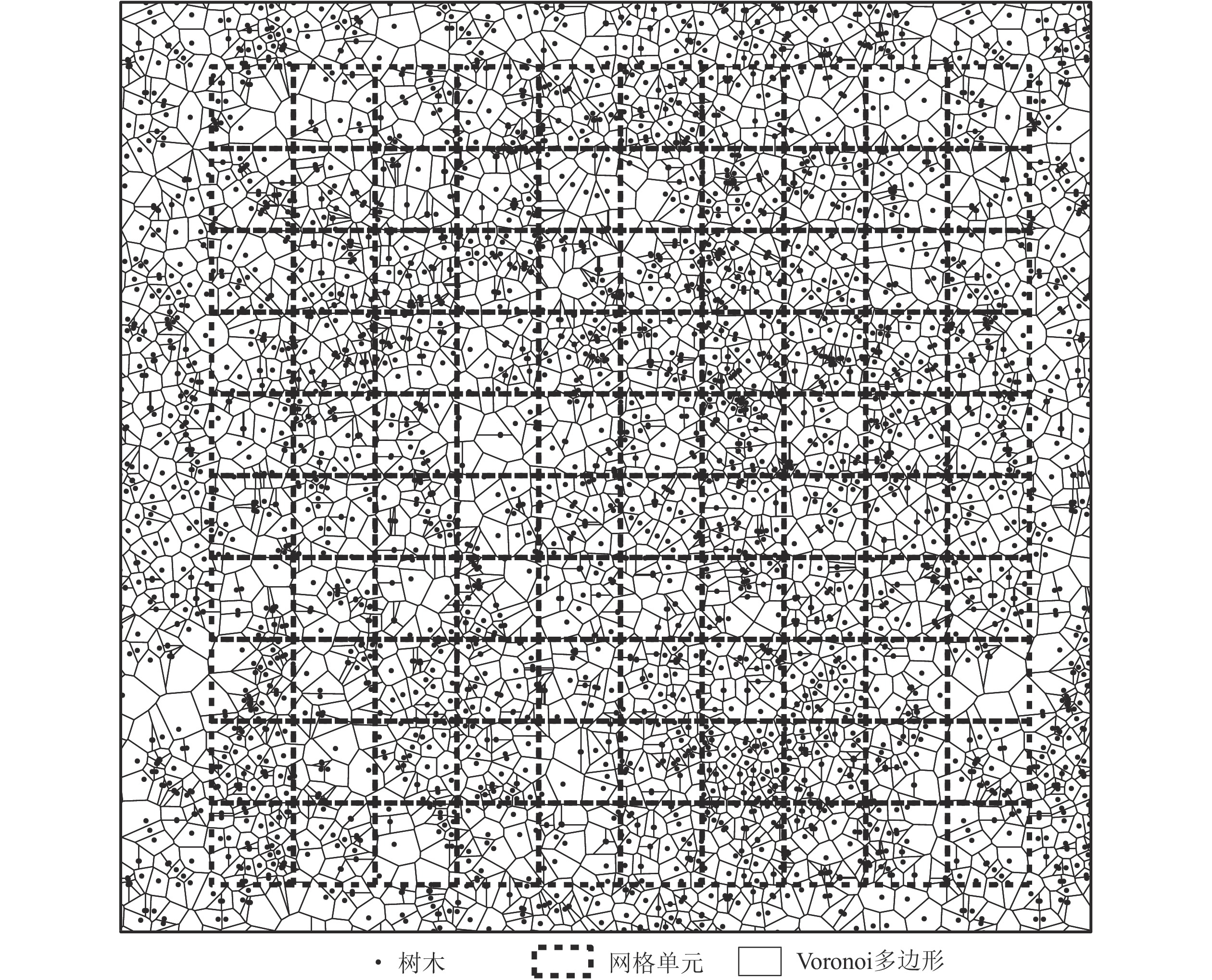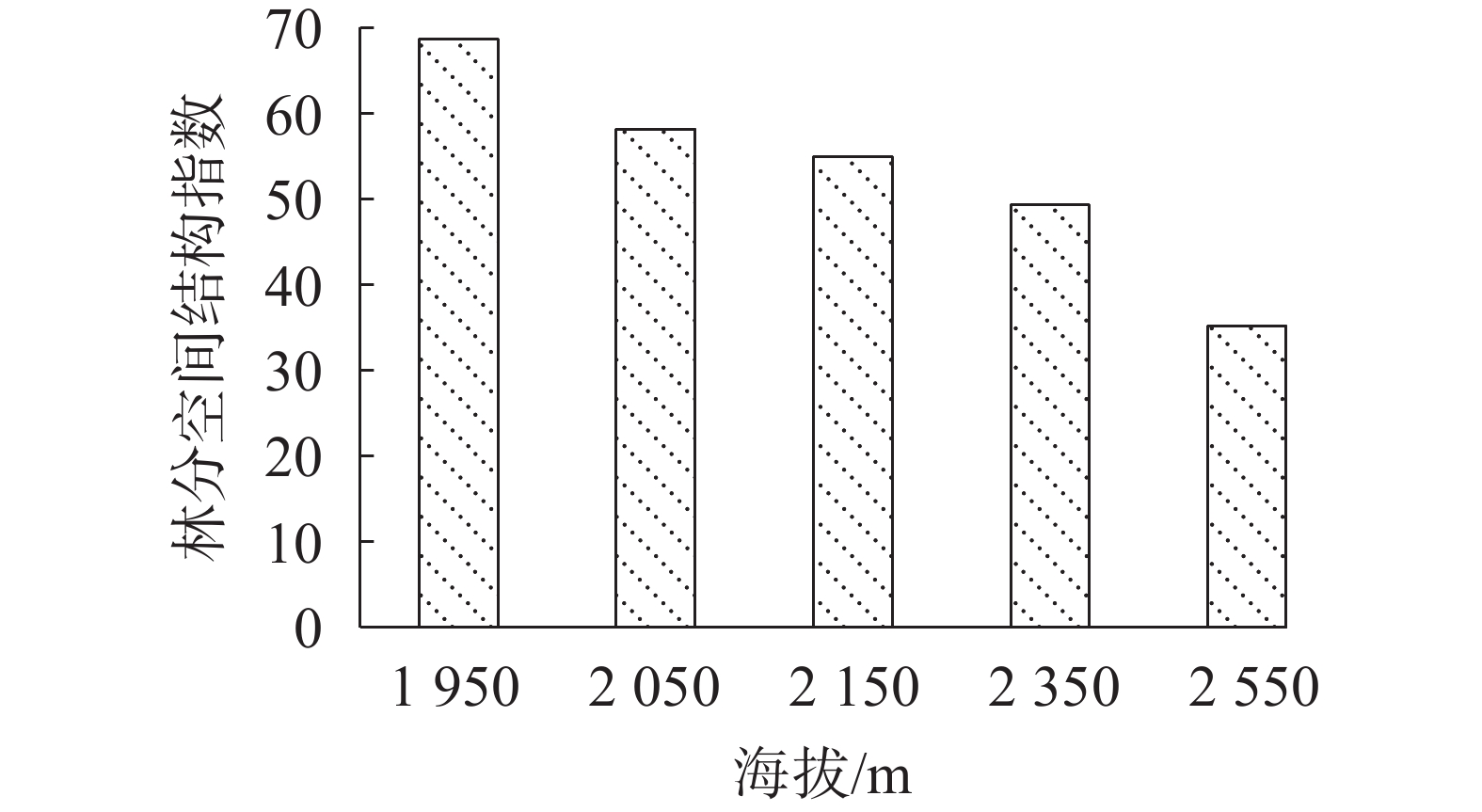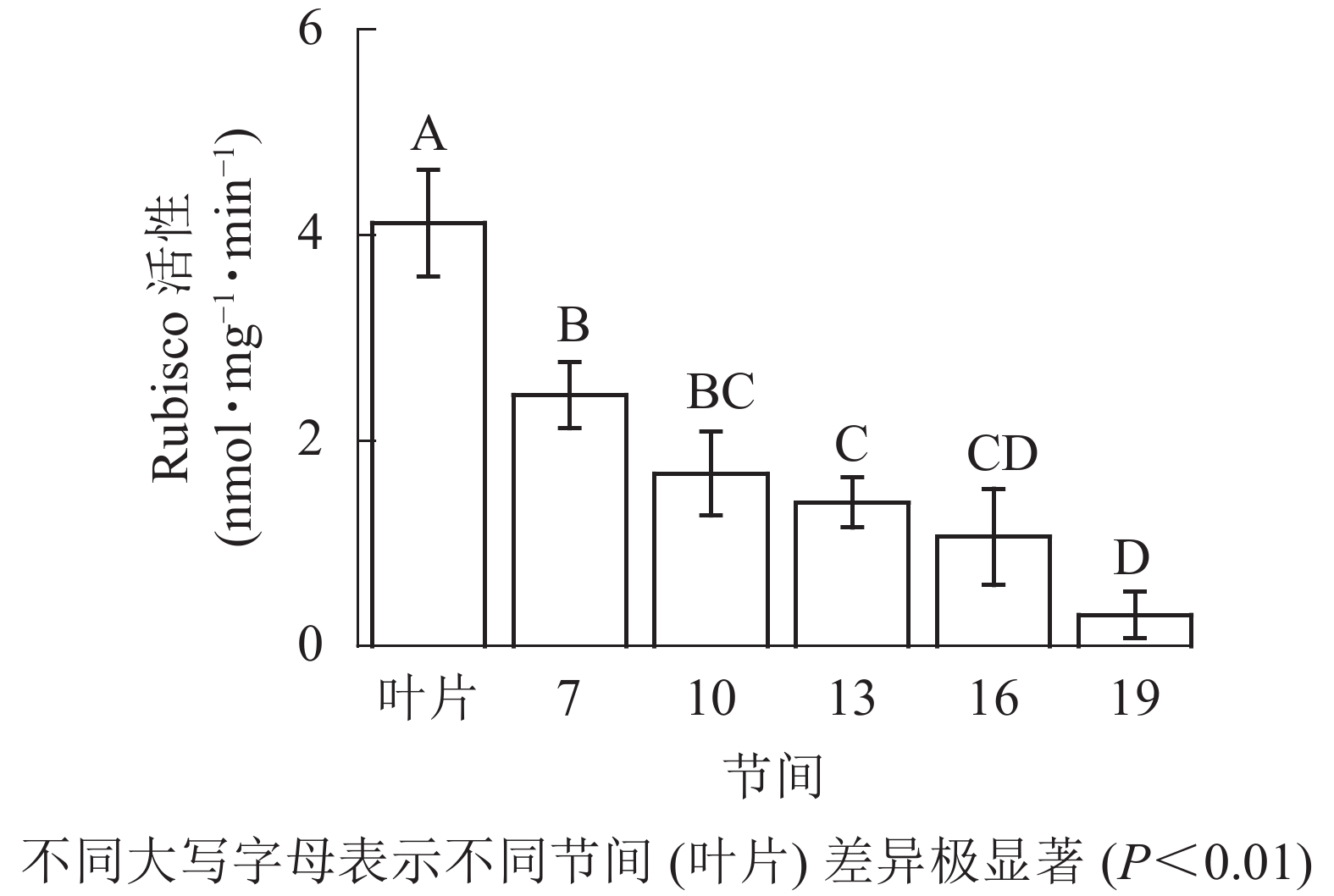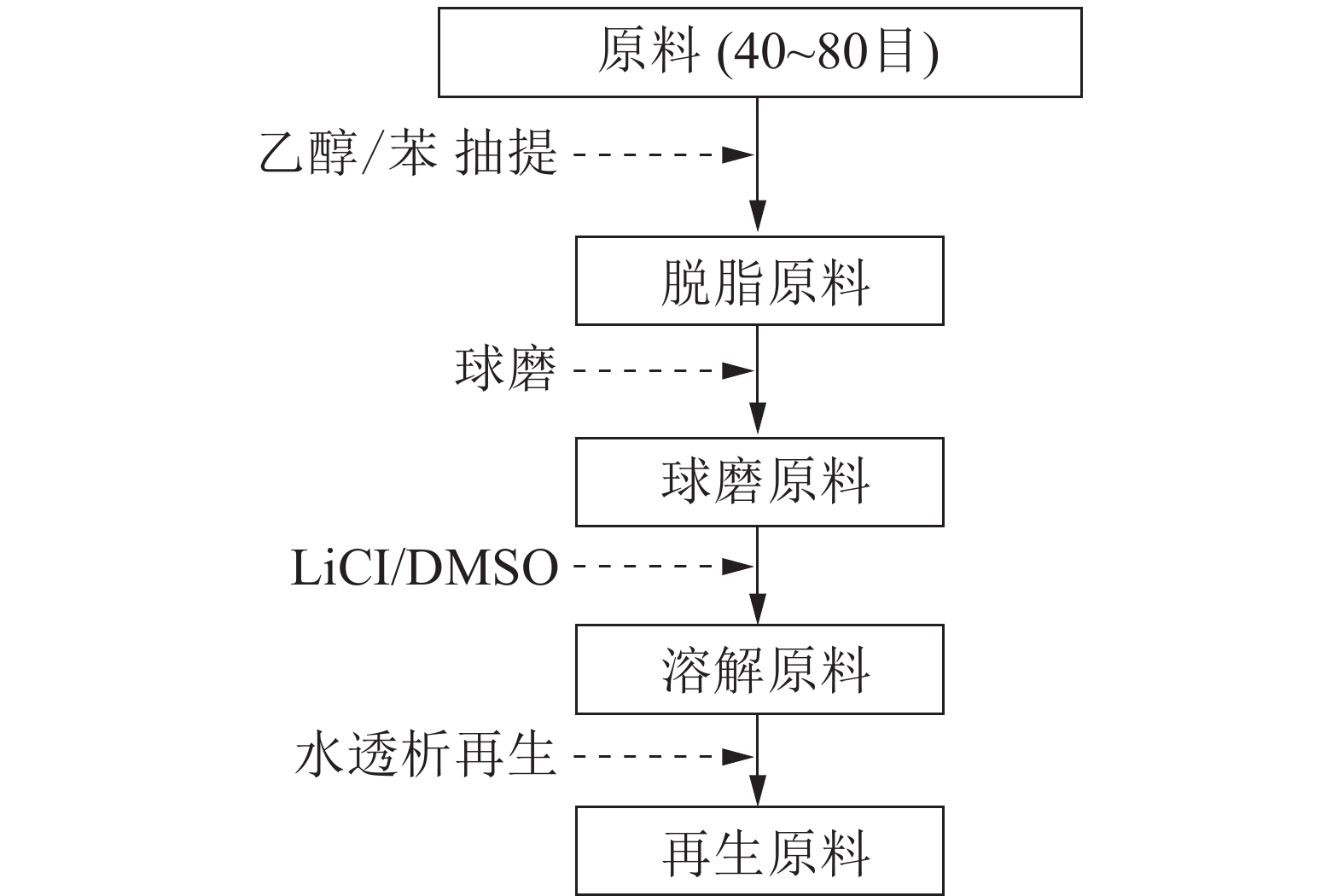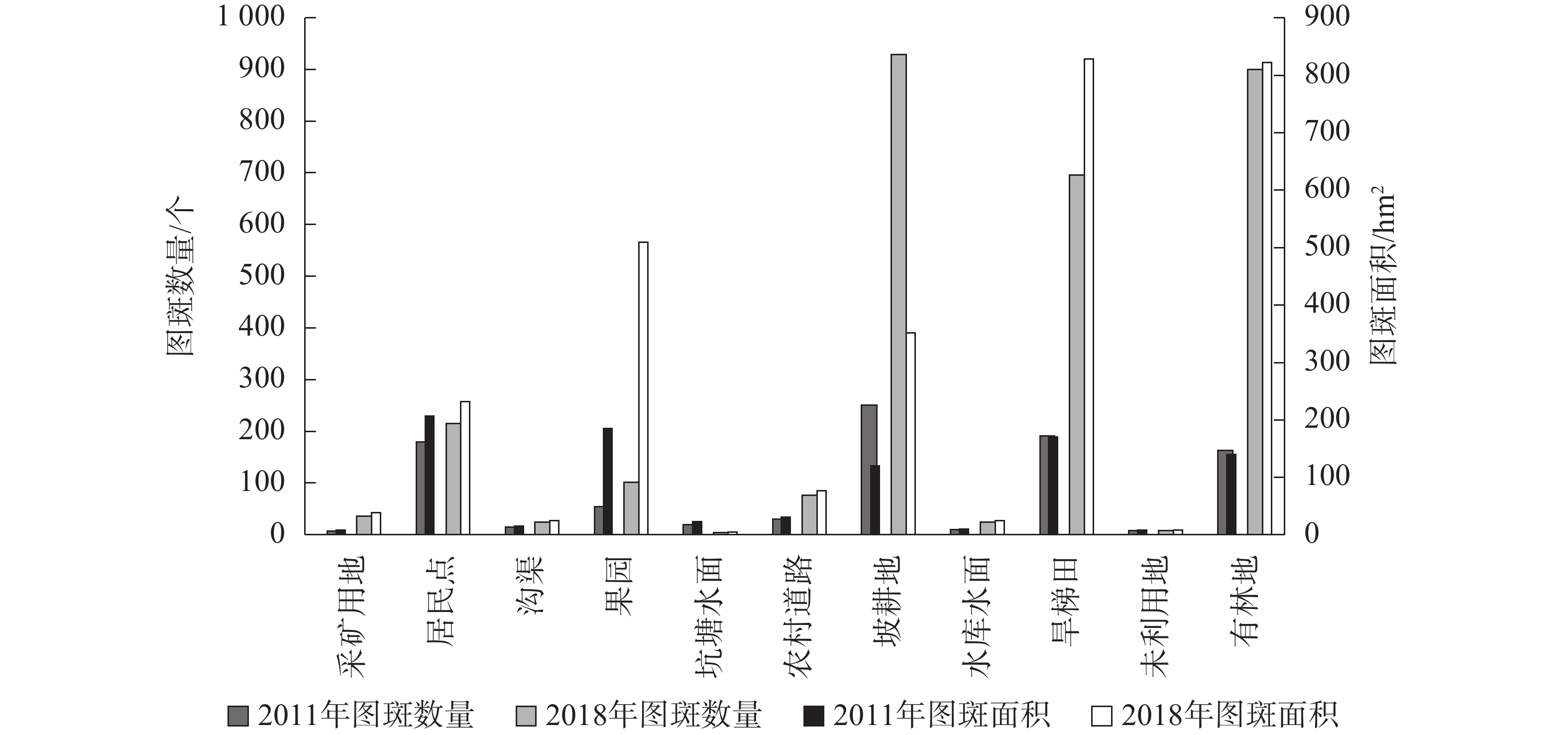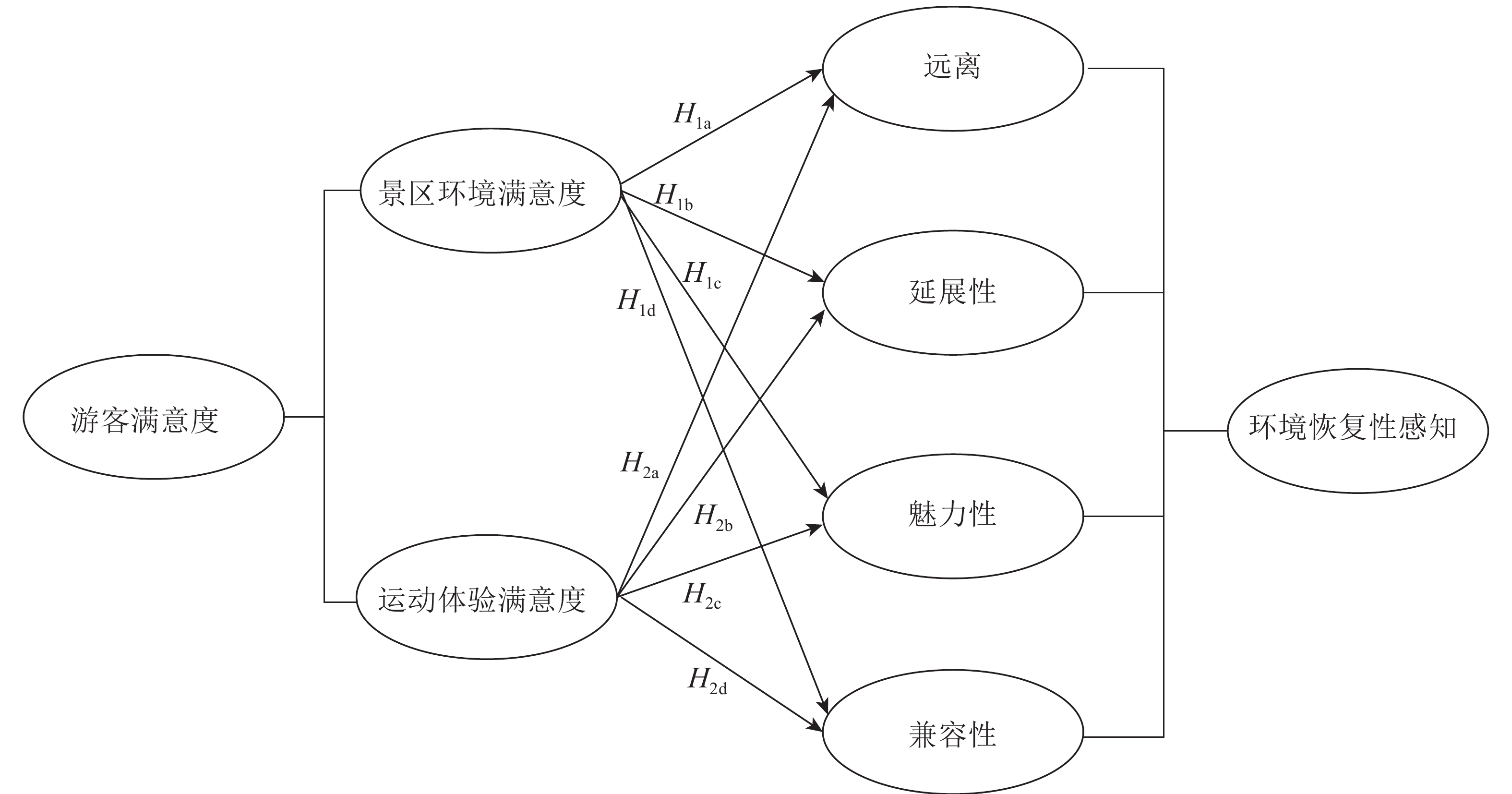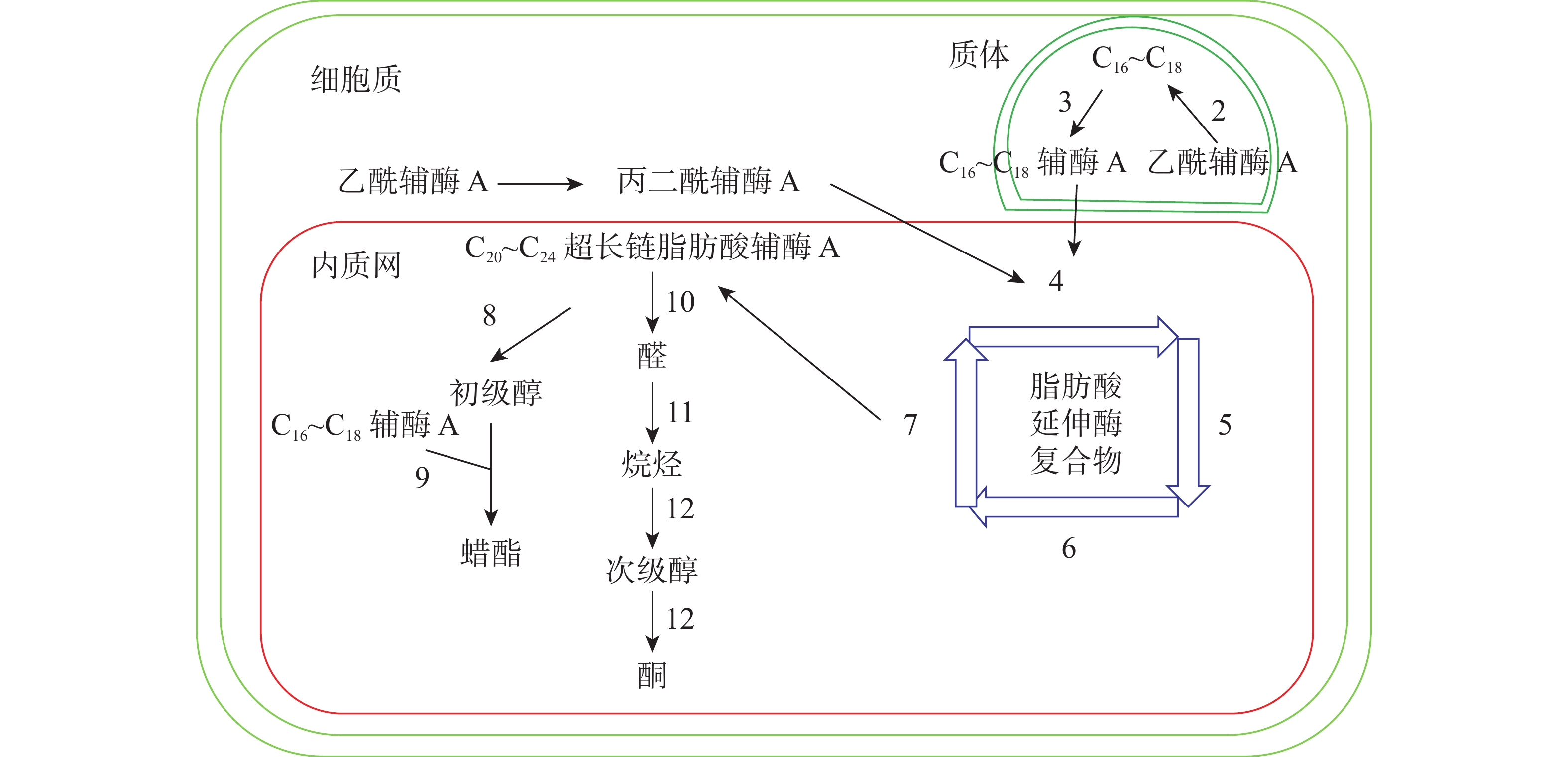2021 Vol. 38, No. 1
2021, 38(1): 1-9.
doi: 10.11833/j.issn.2095-0756.20200283
Abstract:
Objective The purpose is to investigate the content and profile distribution of soil PhytOC in northern subtropical Quercus acutissima forest, and discuss the difference of PhytOC sequestration in Q. acutissima forest at different ages. Method Taking soil samples from Q. acutissima forest of different ages in Jurong City, Jiangsu Province as the research object, the soil samples were collected in layers of 0−10, 10−20, 20−40 and 40−60 cm to determine the content of phytolith, PhytOC, and the PhytOC sequestration in soil of Q. acutissima forest. Result The available silicon content of soil ranged from 45.74 to 153.32 mg·kg−1, which increased with the increase of soil depth. There was no significant difference in the content of soil available silicon among different layers, but there existed significant difference in soil available silicon content among different forest ages (P<0.05). The content of soil phytolith, PhytoOC and organic carbon in phytolith in young forest and mature forest increased first and then decreased with the increase of soil depth, whereas that in half-mature forest decreased with the increase of soil depth. The content of organic carbon in soil phytoliths, PhytoOC and phytoliths was significantly different among different forest ages (P<0.05), but difference was not significant among layers. In addition, the ratio of PhytOC/TOC ranged from 0.36% to 1.49%, which increased with the increase of soil depth. There was no significant difference in the ratio of phytoc/TOC among different soil layers, but there was significant difference among different forest ages (P<0.05). There was an extremely significant positive correlation between soil phytolith content and PhytOC content (P<0.01), but there was no correlation between PhytOC content and available silicon content. The PhytOC sequestrations in the soil of Q. acutissima forest ranged from 1.15 to 1.47 t·hm−2, and the proportions of PhytOC sequestrations to organic carbon storage in young forest, middle-aged forest and mature forest soil accounted for 0.80%−1.50%, 0.73%−1.10% and 0.36%−0.67%, respectively. Conclusion Affected by soil physical and chemical properties, and leaching, etc., the distribution of phytolith and PhytOC in soil profiles of Q. acutissima forest at different ages is different to some extent. The proportion of PhytOC sequestration to organic carbon storage was small, but it increased with the increase of soil depth, indicating that PhytOC is more stable than other forms of carbon. In terms of time scale, PhytOC sink is an important component of long-term carbon sinks in forests. [Ch, 3 fig. 4 tab. 41 ref.]
2021, 38(1): 10-20.
doi: 10.11833/j.issn.2095-0756.20200260
Abstract:
Objective This study aims to investigate soil moisture variation of different vegetation types during the growing season in the loess region of western Shanxi Province, where the eco-environment is fragile and soil moisture is an important factor restricting the vegetation restoration. Method The soil moisture content of 0−400 cm soil layer in the growing season (May to October) in artificial forestland (Robinia pseudoacacia), natural forestland (Acer buergerianum) and grassland (Artemisia lavandulaefolia) was monitored by location observation method. On this basis, the soil active layer was divided according to the standard deviation of moisture content, and the annual soil water storage profit and loss were explored by comparing the water storage before and after the growing season. The soil properties of typical sample plots were measured, and the redundancy analysis of the factors affecting soil water storage capacity was carried out in combination with topography and characteristics of drought and flood in different hydrological years. Result (1) The soil moisture of the artificial forestland, the natural forestland, and the grassland ranged from 8.36% to 9.63%, 10.01% to 3.19% and 15.43% to 19.17%, respectively, and the surface soil moisture content of the grassland was significantly higher than that of the forestlands (P<0.05). (2) The depth of soil water active layer in the natural forestland reached 180 cm, deeper than that of the artificial forestland and the grassland. The soil water active layer was the deepest in moderate humid years, shallower in severe drought years, and the shallowest in normal years. (3) In severe drought years, the depth of soil water deficit of the three types was 100−300, 0−200 and 0−100 cm, respectively. The input and output of soil moisture could keep balance in normal years. In moderate humid years, the moisture content in 0−200 cm soil layer was replenished to different degrees, while the moisture content in 200−400 cm soil layer was close to 0. (4) The soil moisture storage of different soil layers was affected by different environmental factors among which vegetation types and bulk density were the dominant factors of soil moisture in 0−100 cm soil layer, and the water content of 100−200 cm soil layer was mainly controlled by bulk density and slope aspect, while the degree of drought and flood in different hydrological years, the content of soil clay and silt were the dominant factors of soil moisture in 200−400 cm soil layer. Conclusion The soil water deficit is severe in drought years, and is alleviated in normal or wet years. Vegetation types have the greatest impact on soil moisture storage. In the future restoration of vegetation in the Loess Plateau, we should not only consider the drought tolerance of tree species, but also the impact of topography, soil properties, and precipitation distribution during the growing season. [Ch, 5 fig. 5 tab. 33 ref.]
2021, 38(1): 21-30.
doi: 10.11833/j.issn.2095-0756.20200139
Abstract:
Objective The purpose of this study is to explore the effects of different proportions of fungus residue and chemical fertilizer on soil enzyme activities during the rice growth period over a long-term scale. Method A long-term location experiment in paddy field was carried out in which the fertilizer levels were set as 0% (C0), 50% (C50) and 100% (C100) of conventional fertilization amount, and the relative amount of edible fungus residue was set as 0% (F0), 50% (F50) and 100% (F100), respectively. There were 9 treatments in total. The changes of catalase, sucrase and urease activities in different treatments at the main growth stages of rice and the interaction effect of fungus residue and chemical fertilizer on soil enzyme activities were analyzed. Result The soil enzyme activities showed obvious regularity with the change of rice growth period. The catalase, sucrase, and urease activities were 3.01−10.20 mL·g−1, 0.20−2.04 mg·g−1, and 0.54−4.80 mg·g−1 respectively. There were significant differences (P<0.05) in soil catalase, sucrase and urease among the treatments in different growth stages of rice. The results showed that the combined application of fungus residue and chemical fertilizer promoted the soil urease activity in the early stage of rice transplanting, and enhanced the activities of catalase and sucrase in the filling stage and harvest stage. The activities of catalase and urease were the highest in C100F50 treatment, while the sucrase activity was the highest in C50F100 treatment. Path analysis showed that available phosphorus, alkali hydrolyzed nitrogen and total nitrogen had the greatest impact on catalase, sucrase and urease respectively, with path coefficients of 0.69, 1.80, 0.69 respectively. The combined application of fungus residue and chemical fertilizer promoted soil enzyme activity mainly by increasing the mass fraction of alkali hydrolyzed nitrogen. Interaction analysis showed that the effect of combined application of fungus residue and chemical fertilizer was higher than that of chemical fertilizer and fungal residue alone, and the activities of catalase, sucrase and urease in soil were significantly affected (P<0.05). Conclusion The combined application of fungus residue and chemical fertilizer can significantly increase the activities of soil catalase, sucrase and urease, but with the increase of application amount, the activity of soil catalase, sucrase and urease increases first and then decreases. C100F50 treatment is the optimal choice to improve soil enzyme activity and promote carbon and nitrogen cycle under the experimental condition. [Ch, 1 fig. 4 tab. 38 ref.]
2021, 38(1): 31-37.
doi: 10.11833/j.issn.2095-0756.20200262
Abstract:
Objective This study aims to explore the changes of heavy metal content and soil microbial activity in plantations after 2 years of mixed composting of municipal sludge and garden waste, in order to provide basis for utilization of municipal sludge products in forestry. Method A randomized block design was carried out in an experimental Ulmus pumila plantation. According to the sludge content in the compost, four levels of mixed compost (0, 15, 30 and 60 t·hm−2 of composted sludge) were set. After two years of application, soil samples were collected for analysis of six heavy metals(Cr, Pb, Cu, Zn, Cd, Ni), as well as seven soil microbial indicators, including microbial carbon and nitrogen, soil respiration and four enzyme activities. The effects of different fertilization rates on soil quality were analyzed. Result After 2 years of sludge composting, the total amount of six kinds of heavy metals increased, but there was no significant difference between different application amounts, indicating that the application of mixed compost had low risk of heavy mental pollution. Soil enzymes, microbial carbon and nitrogen had no obvious change with increment of compost amount, but the soil enzyme index and soil respiration intensity of the fertilized plot were greater than those of the control plot, suggesting that the mixed compost improved soil microbial activity. Conclusion When the amount of sludge compost is lower than 30 t·hm−2, the elm forest ecosystem could withstand the increased risk of heavy metals, increase soil microbial activity and improve soil quality. [Ch, 1 fig. 4 tab. 22 ref.]
2021, 38(1): 38-46.
doi: 10.11833/j.issn.2095-0756.20200219
Abstract:
Objective The purpose of this research is to prepare a kind of solid microbial inoculant to promote green waste composting by immobilizing lignin-degrading bacteria No.11, with biochar-rice bran as a carrier. Method Through single factor experiment, the optimal range of inoculation amount (5%, 10%, 15%, 20%, 25%), volume fraction of protective agent (0, 4%, 8%, 12%, 16%, 20%) and water content (5%, 10%, 15%, 20%, 25%) were explored, and the best preparation conditions of solid microbial inoculant were found by orthogonal test. Taking a common commercially available microbial inoculant (EM) as an example, the microbial agent was added to the composting process of green waste to explore its effects on lignin and cellulose degradation and related enzyme activities. Result The optimal immobilization conditions of lignin-degrading bacteria No.11 were as follows: 10% inoculation amount, 8% protectant volume fraction and 15% water content. The amount of the effective living bacteria in the prepared fungus reached 1.26×1011 CFU·g−1. Enzyme activities related to lignin degradation(laccase, manganese peroxidase, and lignin peroxidase) were promoted after adding self-made microbial inoculant. Lignin degradation rate increased by 8.69% compared with the addition of EM bacteria. Compared with the control (without inoculant), the degradation rate of lignin and cellulose increased by 23.91% and 8.34%, respectively, and the compost products reached the maturity standard. Conclusion The number of effective viable bacteria of the solid microbial inoculant prepared by immobilizing lignin-degrading bacteria complies with the requirements in Microbial Inoculants in Agriculture (GB 20287−2006). Adding the inoculant to green waste compost can improve the degradation rate of lignin and cellulose and promote the maturity of compost products. [Ch, 3 fig. 3 tab. 36 ref.]
2021, 38(1): 47-57.
doi: 10.11833/j.issn.2095-0756.20200267
Abstract:
Objective The objective of this study is to explore the relationship between spatial structure and terrain factors of evergreen broad-leaved forest in Mount Tianmu, so as to provide scientific reference for the management of evergreen broad-leaved forest. Method Taking the evergreen broad-leaved forest in Mount Tianmu National Nature Reserve of Zhejiang Province as the research object, a large sample of 100 m×100 m was set up and divided into 100 grids of 10 m×10 m investigation units using the method of adjacent grid survey. The trees in the sample plot were measured. The aggregation index, competition index and mingling degree of tree species diversity were used to describe the spatial structure characteristics. Slope, aspect, altitude and roughness were used as terrain factors. The relationship between spatial structure and terrain factors was analyzed by analysis of variance. Result (1) If the slope was too large or too small, the competition index increased significantly (P<0.05). The mingling degree of tree species diversity on the semi-sunny slope was significantly higher than that on the sunny slope (P<0.05), and that in class Ⅰ roughness was significantly lower than that in class Ⅲ roughness (P<0.05). With the increase of the altitude in the plot, the mingling degree of tree species diversity increased significantly (P<0.05), but the aggregation index decreased significantly (P<0.05) when the altitude was too high or too low. (2) In roughness of class Ⅲ, the competition index of classⅠslope was significantly higher than that of classⅡand class Ⅲ (P<0.05), the mingling degree of tree species diversity of classⅡslope was significantly higher than that of classⅠand class Ⅲ (P<0.05), and the aggregation index and the mingling degree of tree species diversity on the semi-sunny slope was significantly higher than those on the sunny slope (P<0.05). In the high altitude area of the plot, the competition index of classⅠslope was higher than that of class Ⅱ and class Ⅲ slope (P<0.05), while in the middle altitude area of the plot, the aggregation index and the mingling degree of tree species diversity of class Ⅲ roughness were significantly higher than those of class Ⅰ and class Ⅱ roughness (P<0.05). Conclusion In evergreen broad-leaved forest community, different terrain factors have different effects on its spatial structure. It is an important management strategy to regulate the spatial structure of evergreen broad-leaved forest under certain terrain conditions. [Ch, 10 fig. 2 tab. 31 ref.]
2021, 38(1): 58-64.
doi: 10.11833/j.issn.2095-0756.20200261
Abstract:
Objective The objective is to analyze the spatial structure of typical secondary forests on shady slope of Luyashan National Nature Reserve, and provide reference for scientific management of natural secondary forest and artificial forest in similar habitats. Method Based on the survey data of Larix principis-rupprechtii-Picea spp. secondary forest communities at five different altitudes on the shady slope of Luyashan National Nature Reserve, the spatial structures of the communities at different altitudes were analyzed by calculating the angle scale, size ratio, mingling degree and forest spatial structure index. Result The average angular scale was 0.51−0.53. The spatial distribution pattern of the forests was dominated by aggregation distributions, but the degree of aggregation was low. The dominant tree species were randomly distributed in the stand. The size differentiation degree of the trees at all altitudes was close to the mean state, and the size differentiation degree of L. principis-rupprechtii was smaller than that of Picea spp., indicating that L. principis-rupprechtii was more competitive. With the increase of altitude, the spatial isolation degree and the spatial structure index decreased. The overall structure of lower altitude stand was better than that of other altitudes. Conclusion The communities of L. principis-rupprechtii-Picea spp. secondary forests in the study area are in late state of succession. The stand at 1 950 m above sea level has the best spatial structure and stability. [Ch, 1 fig. 4 tab. 20 ref.]
2021, 38(1): 65-73.
doi: 10.11833/j.issn.2095-0756.20200209
Abstract:
Objective This study, with an examination of the twig and leaf traits of Michelia wilsonii at different developmental stages, is aimed to research the balanced utilization of such resources so as to better predict the spatial distribution of the branch and leaf traits. Method With the M. wilsonii of Zhougong Mountain in Ya’an selected as the research object, the standardized major axis regression (SMA), principal component analysis (PCA) and geostatistical methods were employed to study the correlation and spatial characteristics of twig and leaf traits at different developmental stages. Result (1) The fresh leaf weight, dry leaf weight, dry matter content, leaf area, specific leaf area, leaf thickness, annual twig density, biennial twig density and biennial twig dry matter content were significantly different among developmental stages (P<0.05), while the annual twig dry matter content was not significantly different among developmental stages (P>0.05); (2) There was a significant correlation between leaf traits among developmental stages (P<0.05) and a significant correlation between twig traits (P<0.05) while the correlation among leaf and twig traits was weak(P>0.05); (3) The optimal model of the semi-variogram function was linear model for the twig and leaf traits among the whole population, with a distribution of randomness while the big tree stage, with a distribution of aggregation, mainly followed the exponential and spherical model; the spatial correlation of small and medium tree stage is weak. Conclusion As developmental stages advance, the yielding of profits by M. wilsonii slows down and the distribution of twig and the employment of the semivariance function can help predict leaf traits. [Ch, 2 fig.7 tab. 30 ref.]
2021, 38(1): 74-83.
doi: 10.11833/j.issn.2095-0756.20200199
Abstract:
Objective To study the effect of different light and nitrogen application on the clonal propagation characteristics and biomass distribution of Dicranopteris dichotoma, aiming to provide a theoretical basis for the development of monolayers of D. dichotoma. Method Three light intensities[light transmittance 35.96%(L1), 13.00%(L2) and 4.75% (L3)], and two nitrogen levels[nitrogen application (N1) and no nitrogen application(N0)]were set up in pot experiments. The effects of light intensity and nitrogen on clonal reproduction characteristics and biomass allocation were analyzed. Result (1) Under the two nitrogen levels, the number of rhizome buds in L2 treatment was the highest. The number of clonal ramets of L3 treatment was significantly lower than that of L1 and L2 (P<0.05). Nitrogen application significantly increased the number of clonal ramets and buds of D. dichotoma under different shading conditions (P<0.05), with an increase rate of 124.7%(L1), 82.8%(L2) and 53.8%(L3) and 70.0%(L1), 125.7%(L2), 122.5%(L3), respectively. (2) Under the two nitrogen levels, the height of clonal ramets increased significantly (P<0.05) with the increase of shading degree, and the length of leaves in L3 shading condition was significantly higher than that in L1 and L2 (P<0.05), but there was no significant difference in leaf width (P>0.05). Under nitrogen application level, the clonal ramet height of L1 and L3 treatments increased significantly (P<0.05), the leaf length in the L1 treatment increased significantly (P<0.05), and the leaf length in L3 treatment decreased significantly (P<0.05). Both plant height and leaf length in L2 treatment did not increase significantly (P>0.05). (3) Under the two nitrogen levels, the aboveground and underground biomass (dry weight) ratio and biomass allocation ratio of clonal ramets in L3 treatment were significantly higher than those in L1 and L2 shading treatments (P<0.05). The rhizome distribution ratio was significantly lower than that of L1 and L2 (P<0.05). The percentage of biomass and leaf allocation of each shading treatment was significantly higher than that of rhizomes (P<0.05), and rhizomes were significantly higher than stems and fine roots (P<0.05). Conclusion L2 treatment is more conducive to the formation of clonal ramets, and nitrogen application is conducive to the enhancement of clonal reproduction capacity. Clonal ramets of L3 treatment can adapt to low-light habitat by increasing plant height, leaf length and biomass leaf allocation ratio. Regardless of the light intensity and nitrogen level, D. dichotoma gives priority to ensuring the growth of feather leaves, followed by rhizomes. [Ch, 2 fig. 5 tab. 38 ref.]
2021, 38(1): 84-92.
doi: 10.11833/j.issn.2095-0756.20200277
Abstract:
Objective The aim is to reveal the law of photosynthetic carbon assimilation of Phyllostachys edulis stem during rapid growth period. Method The activities of ribulose-1,5-diphosphate oxidase (Rubisco), phosphoenolpyruvate carboxylase (PEPC), NADP-malate (NADP-ME), NADP-malate dehydrogenase (NADP-MDH), PEP carboxykinase (PEP-CK) and phosphoene alcohol pyruvate double kinase (PPDK) in the stems of different internodes of Ph. edulis shoots and mature leaves were determined by spectrophotometry, the relative expression of photosynthetic key enzyme genes in the corresponding parts was analyzed by real-time fluorescence quantitative polymerase chain reaction (qPCR). Result The Rubisco activity of the 7−19 internodes of the stems was significantly lower than that of the leaves (P<0.01). With the increase of the internodes, the Rubisco activity gradually decreased first. The activities of PEPC, NADP-ME, NADP-MDH and PPDK in the stems were the highest among the 7th internodes, which were 3.01 times, 5.69 times, 4.46 times and 4.05 times of the leaves (P<0.01), with the increase of internodes, the activity of PEPC, PPDK, NADP-ME and NADP-MDH first significantly reduced (P<0.01). The gene expression levels of PePEPC, PeNADP-ME, PeNADP-MDH and PePPDK in the stems were the highest among the 7th nodes, which were 3.48 times, 7.89 times, 6.48 times and 3.46 times of the leaves (P<0.01). Increased, PePEPC, PeNADP-ME, PeNADP-MDH, PePPDK gene expression was significantly reduced (P<0.01). Conclusion The fast growing stems of Ph. edulis mainly fix the high concentration of CO2 in the bamboo cavity through the NADP-ME and NAD-ME pathways to reduce their own carbon loss, and the carbohydrates formed are rapidly grown and reused by the stalks. [Ch, 13 fig. 1 tab. 37 ref.]
2021, 38(1): 93-102.
doi: 10.11833/j.issn.2095-0756.20200237
Abstract:
Objective With an exploration of the role of early light induced proteins (ELIPs) in photoprotection of bamboo, this study is aimed at providing reference for the further elucidation of the photoprotective mechanism in bamboo. Method The ELIP genes were isolated from moso bamboo (Phyllostachys edulis) leaves using qRT-PCR before an analysis was conducted of their expression profiles under different light conditions employing qRT-PCR and the function of one ELIP gene was initially validated by ectopic expression in Arabidopsis thaliana. Result All the three ELIP genes (PeELIP1, PeELIP2 and PeELIP3) isolated from moso bamboo, with 165, 179 and 182 amino acids encoded respectively have the light-harvesting chlorophyll a/b binding protein domain that consists of three α-helices transmembrane domains, indicating that they belonged with the chlorophyll a/b binding protein superfamily. As was shown in the phylogenetic analysis, PeELIPs were closely related to the ELIPs from monocotyledonous plants including Oryza sativa and Zea mays, which had a high homology of more than 72% and clustered in a same branch. With the employment of qRT-PCR, it was found that the three PeELIPs were weakly expressed in etiolated bamboo seedlings, but their expression was dramatically increased upon light treatment. Meanwhile, with the increase of light intensity and the duration of treatment with strong light stress, they were all upregulated significantly in the normal bamboo leaves. In addition, the over-expression of PeELIP3 in Arabidopsis thaliana inhibited the decline of Fv/Fm under strong light treatment, but it had no effect on non-photochemical quenching coefficient (NPQ). Conclusion In conclusion, at least three homologous genes of ELIPs can be identified from moso bamboo, all with light-inducible expression. On the other hand, the over-expression of PeELIP3 could alleviate the photoinhibition in transgenic Arabidopsis thaliana, implying that PeELIP3 might play a positive role in photoprotection. [Ch, 8 fig. 1 tab. 40 ref.]
2021, 38(1): 103-111.
doi: 10.11833/j.issn.2095-0756.20200212
Abstract:
Objective This research is aimed to study the effects of material tissue and the treatment method on the genome size of bamboo plants with the ultimate purpose to improve the genome size determination accuracy of bamboo plants. Method With the leaves and shoots of different bamboo species selected as materials, and the rice used as the reference standard while the nuclear staining time set for 9 different gradients, that is 1, 3, 5, 7, 9, 12, 18, 24 and 30 minutes, an investigation was carried out of the tissue sites and staining materials of different bamboo plants with the employment of flow cytometry. Result (1) With the same bamboo species, the leaves and shoots were similar in the fluorescence peak and genome size with the genome size difference range as narrow as 0.04~0.20 pg. (2) The 12 bamboo species are different in their nuclear staining time, with the fluorescence intensity of Sinobambusa tootsik, Sinobambusa tootisik f. albo-striata, Pseudosasa japonica var. tsutsumiana, Pseudosasa japonica f. akebono, Indocalamus decorus, Sasaella glabra f. albo-striata and Chimonobambusa mamorea f. variegata reaching the maximum within 1 minute, that of Bambusa multiplex and Phyllostachys sulphurea reaching the maximum within 3 minutes, that of Pseudosasa amabilis var. amabilis and Thyrsostachy ssiamensis reaching the maximum within 5 minutes, while that of Phyllostachys sulphurea (leaf) reaching the maximum within 7 minutes. (3) The fluorescence intensity of the 12 bamboos varies greatly from 1 to 30 minutes, all exceeding 5% except for the leaf of P. amabilis var. amabilis, T. ssiamensis, B. multiplex and the shoot of S. tootsik. In fact, the fluorescence intensity of P. japonica var. tsutsumiana and S. glabra f. albo-striata have reached 12.93% and 12.88% respectively. (4) As for the genome size of 12 bamboo species, 2 tropical woody bamboo species of B. multiplex and T. ssiamensis changed from (2.64±0.54) pg to (2.69±1.01) pg, however, that of the 10 temperate woody bamboo species changed from (3.76±1.51) pg to (5.73±1.85) pg; of the 10 temperate bamboo species, the genome size of Phyllostachys changed from (3.76±1.51) pg to (3.91±0.95) pg, yet that of the other bamboo genus changed from (4.82±0.54) pg to (5.73±1.85) pg, which is obviously larger than Phyllostachys. Conclusion (1) Both leaves and shoots of bamboo can be used as experimental materials to determine their genome sizes by flow cytometry. The nuclear staining time has a certain effect on the determination of the bamboo genome size with 3 to 5 minutes as the optimal staining time. (2)The genome size of tropical woody bamboo species is obviously smaller than that of temperate woody bamboo species while among the temperate woody bamboo species, the genome size of Phyllostachys is obviously smaller than that of the other genus bamboo species. [Ch, 1 fig. 5 tab. 29 ref.]
2021, 38(1): 112-119.
doi: 10.11833/j.issn.2095-0756.20200256
Abstract:
Objective This paper aims to explore the effects of N deposition on Phyllostachys edulis shoots and provide theoretical basis for improving bamboo shoot quality and human health. Method A field experiment was conducted in a subtropical Ph. edulis plantation and the effects of three different levels of simulated N deposition (control: 0 kg·hm−2·a−1, N30: 30 kg·hm−2·a−1, and N60: 60 kg·hm−2·a−1) on the contents of amino acids, nutrients (vitamin C, crude fiber, crude protein, and soluble sugar) and mineral elements in Ph. edulis shoots were studied. Result N deposition significantly affected the nutrient quality and mineral elements of Ph. edulis shoots. Nitrogen deposition significantly increased the contents of total amino acids, essential amino acids, and sweet amino acids (P<0.05). High N deposition (N60) significantly increased the contents of umami amino acids, bitter amino acids, and aromatic amino acids (P<0.05), while low nitrogen deposition (N30) had the opposite effect. Nitrogen deposition significantly increased the proportion of sweet amino acids (P<0.05), but significantly decreased the proportion of essential amino acids, umami amino acids, bitter amino acids, and aromatic amino acids (P<0.05), and significantly reduced vitamin C content(P<0.05) but increased crude fiber content, and had no significant effect on the content of crude protein and soluble sugar. Nitrogen deposition significantly increased the contents of Se, Fe and Na but significantly decreased the content of Cu (P<0.05). Low N deposition (N30) significantly increased Mn, Ca and Mg contents, while the N60 treatment was the opposite(P<0.05). Conclusion Moderate N deposition has a certain promotion effect on nutritional components of Ph. edulis shoots, which is conducive to the improvement of bamboo shoot quality and human health. [Ch, 2 fig. 2 tab. 41 ref.]
2021, 38(1): 120-127.
doi: 10.11833/j.issn.2095-0756.20200161
Abstract:
Objective This research aims to study the effects of exogenous brassinolide (BR) on physiological characteristics of Phyllostachys edulis, and to provide theoretical basis and technical reference for future cultivation and management of Ph. edulis. Method The seedlings of Ph. edulis were used as test materials, and 6 kinds of brassinolide solutions with different concentrations[0(ck), 0.050 0, 0.010 0, 0.005 0, 0.001 0, 0.000 5 mg·L−1] were set up through hydroponic culture experiment to compare the differences in the growth characteristics, photosynthetic pigment, photosynthetic characteristics and antioxidant system of the seedlings. Result On the whole, compared with ck, brassinolide with different mass concentrations could promote the growth and development of Ph. edulis seedlings to varying degrees, improve the quality of photosynthetic pigments and photosynthetic capacity, and promote the synthesis of osmotic adjustment substances. Compared with ck, when the mass concentration of brassinolide was 0.005 0 and 0.001 0 mg·L−1, the superoxide dismutase activity of bamboo seedlings increased by 6.7% and 6.1%, respectively, oxidase activity increased by 14.6% and 13.7%, and catalase activity increased by 8.2% and 14.6%, respectively. The mass fraction of soluble protein increased by 31.5% and 31.2%, and the mass fraction of starch increased by 17.3% and 16.9%, respectively. However, compared with 0.005 0 and 0.001 0 mg·L−1 treatment, brassinolide treated with mass concentration of 0.050 0, 0.010 0 and 0.000 5 mg·L−1 had no significant effect on antioxidant capacity and osmotic adjustment ability of Ph. edulis seedlings. Conclusion Brassinolide can improve the photosynthetic capacity and stress resistance of Ph. edulis seedlings, and promote nutrient growth. The best concentration of brassinolide is 0.005 0−0.001 0 mg·L−1.[Ch, 5 tab. 42 ref.]
2021, 38(1): 128-137.
doi: 10.11833/j.issn.2095-0756.20200303
Abstract:
Objective With the changes of main mineral element contents in the annual growth cycle of the Paeonia ostii ‘Feng Dan’ measured, the current study is aimed at an analysis of the fertilizer requirement and nutrient diagnosis for the oil peony. Method With ‘Feng Dan’ (eight years old), an oil peony cultivar selected as the study subjects, the mineral elements content of roots, stems and leaves were measured across the growth stages of the oil peony. Result The content of P in roots, stems and leaves, and the content of N in roots and leaves decreased gradually as the growth cycle of the peony proceeds, while the changes of K and Mg vary from part to part. The content of Fe was significantly more than any other trace elements in the roots, stems and leaves, and increased first and then decreased across the growth cycle. All of the trace elements, except for Cu, have showed first an increase and then a decrease in content in the roots. As the process of fruit development advanced, the content of N increased, with the content of K in fruit pods and P in seeds displaying a trend of decrease, increase and decrease. The changes of mineral elements in roots, stems and leaves of the peony showed different degrees of correlation across the peony’ s growth cycle, with N、P、K、Fe and Mn closely related to most of the other mineral elements. The same mineral elements displayed different correlations with vegetative organs and reproductive organs. Conclusion Throughout one growth cycle, the oil peony ‘Feng Dan’ has a large demand for N and P from the leaf-growth stage to the current bud stage, and N and P fertilizers should be applied before the leaf-growth stage; and there is a large demand for N, P and K during the fruiting period, and it is recommended to apply N, P and K fertilizer after the flowering of the peony. Fe fertilizer should be applied before the budding stage (early March) while B and Zn fertilizers should be applied during the seed development stage from May to July to meet the demand of ‘Feng Dan’ plants for these three microelements. [Ch, 7 tab. 36 ref.]
2021, 38(1): 138-146.
doi: 10.11833/j.issn.2095-0756.20200190
Abstract:
Objective Aimed at a study of the color parameters and the pigment content of Juniperus colored leaves. Method Two-year-old cutting seedlings of Juniperus communis ‘Gold Cone’ (JC) and Juniperus×media ‘Pfitzeriana Aurea’ (JM) were used to determine the leaf color parameters (L*, a*, b*), relative content of photosynthetic pigments (chlorophyll a, chlorophyll b, carotenoids) and anthocyanins, with a correlation analysis conducted to establish the regression equation of leaf color parameters and pigment content. Result (1) The changing trends of leaf color parameters of JC and JM are different in different seasons: the L* and b* values of JC have the same changing trend and are always positive, and the a* value increases significantly in autumn and winter from negative to positive. The L* value of JM rises significantly in spring and summer, with the fluctuation of a* value unobvious, the hue always greenish whereas the b* value rises significantly in spring and summer with no fluctuation in autumn and winter, and the hue always yellow. The L* and b* values of JC in spring, summer and autumn are significantly higher than those of JM. (2) The relative content of anthocyanin in JC has a very significant negative correlation with L* and b* values, and a very significant positive correlation with a* value while JM photosynthetic pigments have a very significant negative correlation with b* value. (3) The results of the stepwise regression equation show that the a* and b* values can accurately predict the annual and autumn changes of the anthocyanin content of JC, and the b* and L* values can accurately predict the annual and summer changes in the photosynthetic pigment content of JM pigment changes. Conclusion The relationship between leaf color parameters and pigment content of the two color trees of Juniper genus is significantly correlated with differences in different tree species during in different periods and the leaf color of JC generally better than that of JM. The established regression equation of leaf color parameters and pigment content can help make an accurate estimation of leaf pigment content based on leaf color parameters. [Ch, 2 fig. 4 tab. 32 ref.]
2021, 38(1): 147-154.
doi: 10.11833/j.issn.2095-0756.20200163
Abstract:
Objective With the straw of Oryza sativa selected as raw materials, this study is aimed at an investigation of the dissolution behavior and regeneration characteristics of straw samples dealt with the LiCl/DMSO solvent system. Method With the national standard method employed, the four samples of straw (internode with knot, stem without knot, leaf and whole straw)were treated with the LiC1/DMSO system before an analysis was conducted of the general chemical composition of cellulose, hemicellulose, lignin and ash. On top of this, the effect of dissolution and regeneration of rice straw on the cellulose crystallization zone was investigated with the crystallinity calculated employing X-ray diffraction after the yield of lignin structural units produced by alkaline nitrobenzene oxidation was measured and the condensed degree of lignin was analyzed. Result (1) Both of stem and leaf with 1.0 h ball milling could be completely dissolved in LiCl/DMSO solvent system with a dissolution rate up to 10% even in the 8% LiCl/DMSO solvent system; (2) After water regeneration, more than 80% of the lignin could be retained with that of the stem reaching 87.5%; (3) The cellulose crystallinity was decreased from 37.8% to 27.5% for the leaf and from 43.1% to 26.5% for the stem; (4) The uncondensed units of lignin of all four samples were increased, as observed in the results of alkaline nitrobenzene oxidation. Conclusion (1) Both ball milling time and LiCl concentration affect the dissolution of rice straw in LiCl/DMSO solvent system; (2) In terms of regeneration, the chemical content displays high capacity and in comparison, that of the cellulose and lignin was the lowest in leaf sample while with a different ash distribution, the regeneration capacity of the leaf was higher than that of the stem; (3) After ball milling, the condensation degree of lignin decreases while the oxidation environment of nitrobenzene and homogeneous reaction was improved; (4) After regeneration, it was showed in the X-ray diffraction analysis that the crystalline region of cellulose was damaged to a certain extent and the crystallinity decreased. [Ch, 6 fig. 4 tab. 36 ref.]
2021, 38(1): 155-164.
doi: 10.11833/j.issn.2095-0756.20200279
Abstract:
Objective With a quantitative analysis conducted of the changes in the landscape pattern in Shennongjia Forestry District due to the implementation of forest protection projects since 1990s as well as their driving mechanisms, this study is aimed to explore the effectiveness of the conservation in this region and provide a reference for the future ecological environment protection and rational land use. Method Supported by remote sensing (RS) and geographic information system (GIS) technology and taking Shennongjia Forestry District as the research object, with remote sensing images from three different periods of 1996, 2007 and 2018 selected as data sources, this paper has mainly employed land use transfer matrix, landscape pattern distribution center of gravity model and landscape pattern index. Result Between 1996 and 2018, the landscape of forest land and water areas has retained a stable and favorable state while there is a general decrease in the area of grassland and cultivated land showed; There has been a more significant tendency in the conversion of other land types to construction land and such changes mainly attribute to human factors. Conclusion Ecological protection and restoration projects such as returning farmland to forests in Shennongjia Forestry District have been rewarded with a better integrated landscape pattern, enhanced landscape diversity in spite of aggravated local fragmentation as well as more favorable socioeconomic and ecological space. On the other hand, due attention should be paid to threats against ecological security induced by the booming local tourism with various natural landscapes replaced by artificial patches. [Ch, 4 fig. 5 tab. 32 ref.]
2021, 38(1): 165-172.
doi: 10.11833/j.issn.2095-0756.20200168
Abstract:
Objective This study aims to discuss the governance effect of the National Key Soil and Water Conservation Project after implementation. Method Taking the small watershed of Zhangjia Village in Mengyin County of Shandong Province as an example, and soil and water conservation in basic spot and effect spot as the unit, the changes of land use, forest and grass vegetation coverage, soil and water conservation measures, and soil and water loss before and after the implementation of the National Key Soil and Water Conservation Project were compared and analyzed through investigation, measurement and field review, based on high-resolution remote sensing, UAV, mobile terminal and other technologies. Result (1)After the implementation of the project, there were 339 plot changes, covering an area of 870.60 hm2. The change direction was mainly from slope farmland/dry terrace into orchards, followed by slope farmland into dry terrace. (2)The basic annual forest and grass coverage rate was 31.13%, and the assessed annual forest and grass coverage rate was 45.69%. The coverage rate was mainly medium and high (60%–75%), and the improvement rate of forest and grass coverage was 14.56%. (3) The conservation rate of soil and water conservation measures was the highest in reservoir (100.00%), the lowest in millet workshop (55.56%), and the conservation rate of other soil and water conservation measures was above 80.00%. (4) The area of soil and water loss reduced by 400.39 hm2 in the evaluation year compared with the base year, the reduction rate of soil and water loss was 23.21%, and the degree of soil and water loss control was 76.78%. Conclusion Through implementation of the National Key Soil and Water Conservation Project, the ecological environment in the small watershed of Zhangjia Village in Mengyin County has been significantly improved, which is mainly reflected in the reduction of soil and water loss and the increase of forest and grass vegetation coverage. [Ch, 5 fig. 5 tab. 11 ref.]
2021, 38(1): 173-183.
doi: 10.11833/j.issn.2095-0756.20200306
Abstract:
Objective From the perspective of forest carbon sequestration demand, this study aims to calculate and analyze enterprise emission reduction cost, forest carbon sequestration demand price and policy influencing factors, so as to better understand the market demand potential of forest carbon sequestration and promote the development of forest carbon sequestration market. Method Taking Beijing, Shanghai, Hubei and Guangdong as the case areas, three carbon emission intensive representative industries, namely thermal power, chemical industry and steel, were selected to calculate the carbon marginal emission reduction cost of 89 emission reduction units of 2 759 samples by directional distance function method. Then, the Robin Stein game model was used to measure the demand price of forest carbon sink, and the cloud model was used to measure the demand price of forest carbon sink of enterprises in different industries and regions, and the impact of policy changes on the price was simulated. Result The average demand price of forest carbon sequestration in thermal power industry, steel industry and chemical industry was 631, 556 and 575 yuan·t−1 respectively, and the average value of enterprises in Shanghai, Beijing, Guangdong and Hubei was 305, 456, 877 and 715 yuan·t−1 respectively. Cloud model simulation analysis showed that with the increase of the proportion of carbon sequestration offset and the increase of carbon sequestration subsidies, the demand price of forest carbon sequestration of various industries and provinces and cities increased. With the increase of carbon tax collection rate, the demand price showed a downward trend. Conclusion The marginal cost of carbon dioxide emission reduction in different regions and different industries varies greatly and increases year by year. Forest carbon sequestration is the trend of future emission reduction. At present, thermal power industry enterprises have officially launched the national carbon emission trading market. The cloud model simulation results show that the chemical industry is more vulnerable to policy influence than the other two industries. Therefore, under the reasonable combination of allowable offset ratio and subsidy policy, thermal power and chemical industry will be the major demanders of forest carbon sequestration in the future, and the development potential of forest carbon sequestration market is huge.[Ch, 4 fig. 5 tab. 28 ref.]
2021, 38(1): 184-192.
doi: 10.11833/j.issn.2095-0756.20200243
Abstract:
Objective This study aims to investigate the relationship between environmental perception, sports experience and health efficacy of scenic spots. Method Using random sampling, the tourists in Lingjiu mountain forest sports town in Quzhou City of Zhejiang were investigated by questionnaire to obtain the relevant data. The structural equation was used to analyze the impact of environmental perception and leisure sports experience satisfaction of forest sports scenic spots on tourists’ environmental restoration perception. Result (1) The environmental perception satisfaction had a significant positive impact on tourists’ perception of environmental restoration. The mean value of standardized path coefficient was 0.26. The influence of the four dimensions on environmental restoration perception from large to small was ductility (0.29), charisma (0.27), compatibility (0.25), distance (0.23). Among the elements of environmental perception in forest scenic spots, the load of ecological environment quality on tourists’ satisfaction of forest environmental perception was the largest, which was 0.74. (2) Leisure sports experience satisfaction had a significant positive impact on tourists’ perception of environmental restoration (P<0.05). The average value of standardized path coefficient was 0.86, and the degree of influence on the four dimensions of environmental restoration perception from large to small was distance (0.90), compatibility (0.88), charisma (0.84), ductility (0.82), which showed little difference between the four dimensions. In the satisfaction of leisure sports experience, the load of sports facilities and sports interest was the largest, both were 0.59. (3) From the difference of path coefficient, the effect of leisure sports experience satisfaction on environmental restoration sensitivity (0.86) was significantly higher than that of environmental perception satisfaction of scenic area (0.26). Conclusion Both the environmental quality of forest scenic spots and forest leisure sports experience have a significant positive impact on tourists’ perception of environmental restoration, but the impact of forest leisure sports experience is greater than that of scenic spots. The most important factor affecting the satisfaction of forest scenic spot environmental perception is the quality of ecological environment, and the biggest factor affecting the satisfaction of leisure sports experience is the richness of sports facilities and the interest of forest sports. For forest sports tourist attractions, more attention should be paid to how to improve the richness and interest of forest leisure sports. [Ch, 2 fig. 1 tab. 24 ref.]
2021, 38(1): 193-204.
doi: 10.11833/j.issn.2095-0756.20200234
Abstract:
The study of plant population ecology aims to explore the development dynamics, distribution of population, and its interaction with other biological and abiotic factors in the habitat, which is of great theoretical and practical significance for understanding ecosystem balance, biodiversity and ecological protection. Stellera chamaejasme is one of the typical poisonous weeds in degraded grassland. An investigation into its population ecology and reproductive biology can provide scientific and theoretical basis for the control and restoration, resource management, and ecological protection of degraded grassland of this type. In this paper, the research results on spatial distribution pattern, population diffusion and colonization of S. chamaejasme were summarized. The breeding system characteristics, pollination syndrome and reproductive allocation strategies of S. chamaejasme were expounded. The allelopathy and ecological function of S. chamaejasme were discussed. Finally, the future research was prospected based on the current research results. The main conclusions are as follows: the spatial distribution pattern of S. chamaejasme population shows clumped(aggregation), random and uniform distribution, and the distribution pattern of seed near the mother plant and its low germination rate affect the population diffusion. S. chamaejasme, with its self-incompatibility system, is a typical outcrossing plant, and its floral features show the pollination syndrome of moths and butterflies in order Lepidoptera. With the change of habitat at different altitude and slope direction, the reproductive allocation strategy of S. chamaejasme is different. S. chamaejasme can release allelopathy substances through root secretion or residual decay, and exert positive or negative effects on other species of grassland community by changing soil nutrients, so as to influence community structure and ecological function. In the future, studies on population ecology of S. chamaejasme should focus on the ecological mechanism of spatial distribution pattern formation, habitat selection of invasion, settlement and propagation in grassland communities, and the ecological relationship between population diffusion and grassland degradation. [Ch, 1 fig. 106 ref.]
The study of plant population ecology aims to explore the development dynamics, distribution of population, and its interaction with other biological and abiotic factors in the habitat, which is of great theoretical and practical significance for understanding ecosystem balance, biodiversity and ecological protection. Stellera chamaejasme is one of the typical poisonous weeds in degraded grassland. An investigation into its population ecology and reproductive biology can provide scientific and theoretical basis for the control and restoration, resource management, and ecological protection of degraded grassland of this type. In this paper, the research results on spatial distribution pattern, population diffusion and colonization of S. chamaejasme were summarized. The breeding system characteristics, pollination syndrome and reproductive allocation strategies of S. chamaejasme were expounded. The allelopathy and ecological function of S. chamaejasme were discussed. Finally, the future research was prospected based on the current research results. The main conclusions are as follows: the spatial distribution pattern of S. chamaejasme population shows clumped(aggregation), random and uniform distribution, and the distribution pattern of seed near the mother plant and its low germination rate affect the population diffusion. S. chamaejasme, with its self-incompatibility system, is a typical outcrossing plant, and its floral features show the pollination syndrome of moths and butterflies in order Lepidoptera. With the change of habitat at different altitude and slope direction, the reproductive allocation strategy of S. chamaejasme is different. S. chamaejasme can release allelopathy substances through root secretion or residual decay, and exert positive or negative effects on other species of grassland community by changing soil nutrients, so as to influence community structure and ecological function. In the future, studies on population ecology of S. chamaejasme should focus on the ecological mechanism of spatial distribution pattern formation, habitat selection of invasion, settlement and propagation in grassland communities, and the ecological relationship between population diffusion and grassland degradation. [Ch, 1 fig. 106 ref.]
2021, 38(1): 205-213.
doi: 10.11833/j.issn.2095-0756.20200138
Abstract:
Mainly composed of vegetables, oil crops, medicinal plants, ornamental plants and dyewood, Brassicaceae is a plant that can be annual, biennial or perennial, also as the most important family of vegetable and oil crops in China. Wax, comprised with very long chain fatty acids and corresponding derivatives, a layer of protective structure formed on plant surface to adapt different environmental conditions, plays an important role in resistance to biotic and abiotic stresses. It helps maintain water balance, reflect ultraviolet rays, reduce external mechanical damage, decrease low temperature damage, resist invasion of bacteria and fungi, prevent fruit cracking and fight off insect invasion. This paper, with a brief review of the type, physiological function, genetic characteristics, biosynthetic and transport pathways of wax, is intended to provide reference for the study of wax metabolism in Brassicaceae plants. [Ch, 2 fig. 2 tab. 61 ref.]
Mainly composed of vegetables, oil crops, medicinal plants, ornamental plants and dyewood, Brassicaceae is a plant that can be annual, biennial or perennial, also as the most important family of vegetable and oil crops in China. Wax, comprised with very long chain fatty acids and corresponding derivatives, a layer of protective structure formed on plant surface to adapt different environmental conditions, plays an important role in resistance to biotic and abiotic stresses. It helps maintain water balance, reflect ultraviolet rays, reduce external mechanical damage, decrease low temperature damage, resist invasion of bacteria and fungi, prevent fruit cracking and fight off insect invasion. This paper, with a brief review of the type, physiological function, genetic characteristics, biosynthetic and transport pathways of wax, is intended to provide reference for the study of wax metabolism in Brassicaceae plants. [Ch, 2 fig. 2 tab. 61 ref.]
2021, 38(1): 214-218.
doi: 10.11833/j.issn.2095-0756.20190731
Abstract:
Objective In order to clarify the control effect of different chemical insecticides on the larvae of the Melanotus cribricollis, a virulence test was carried out on the larvae stage for the present study. Method With 5.0% phoxim granules, 0.5% fipronil powder and 20.0% chlorantraniliprole suspension selected and mixed into sand and bamboo forest soil in a 1∶2 ratio with 5 concentration gradients, to observe the mortality rate of M. cribricollis after 24 hours in contrast with a control group where water was sprayed without any insecticides. Result The three selected chemical insecticides all have certain control effects on M. cribricollis, with the control effect from strong to weak: 5.0% phoxim>0.5% fipronil>20.0% chloranthrene Benzoamide. It was found that the 5.0% phoxim has the best control effect, with an LC50 of 0.190 0 g·kg−1, followed by 0.5% fipronil, with an LC50 of 0.950 0 g·kg−1, and 20.0% chlorantraniliprole which has the weakest control effect with a LC50 of 1.820 0 g·kg−1. Conclusion With control effectiveness, toxicity and control costs taken into consideration, 5.0% phoxim Phosphorus granules and 0.5% fipronil are suitable for the control of bamboo forest pests M. cribricollis, yet with the need to further explore the application methods and relevant technologies of forest chemicals. [Ch, 2 tab. 27 ref.]
2021, 38(1): 219-224.
doi: 10.11833/j.issn.2095-0756.20200268
Abstract:
Objective This study aims to explore the natural regeneration status of Alcimandra cathcartii, a National GradeⅠProtection plant, in order to better protect this species. Method By setting sample circles to investigate the natural regeneration of A. cathcartii, the spatial pattern and regeneration of this species were studied. Result (1) The ratio of index variance (S2) to mean of the distribution pattern (m) was 4.14, which was significantly greater than “1.00”, indicating that the distribution of individuals was uneven, and the distribution of saplings in the survey circle was cluster type. (2) 67 regenerated plants were recorded in 8 sampling circles. According to the diameter class distribution of the seedlings, the regeneration proportion of young, small and medium trees was 46.27%, 32.83% and 20.90%, respectively. The regeneration number showed a pyramid structure, indicating that the structure was relatively stable although the regeneration number was small. (3) The proportion of regenerated plants at 0°−90°, 90°−180°, 180°−270° and 270°−360° was 26.86%, 19.40%, 20.90% and 32.84%, respectively. There were some differences in the number of regenerated plants in each angle range, but the variance analysis of the number of trees showed there was no significant difference in the number of regenerated plants in different azimuth angles. (4) The regeneration of A. cathcartii was correlated with the distance between mother trees. Within the distance of 0−5, 5−10, 10−15, 15−20, 20−25 and 25−30 m from mother trees, the proportion of regenerated plants was 11.94%, 34.33%, 23.88%, 22.39%, 5.97% and 1.49% respectively. The regeneration was mainly distributed in the range of 5−20 m from the mother tree, accounting for 80.60% of the total number of regenerated plants. The variance analysis showed there were significant differences between the distance from the mother tree and the regeneration distribution of A. cathcartii. Conclusion The regeneration number of A. cathcarti is small and the distribution scope is narrow, so it is difficult to expand the population. Artificial promotion is suggested for its population generation and expansion. [Ch, 7 tab. 17 ref.]






